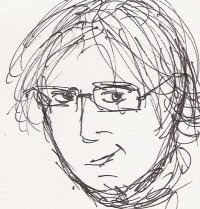One of the greatest things about being a Beatle fan is that you are always exposed to different types of music, whether you want to be or not. Through early Beatle albums, Paul exposed us to show tunes and John and George showed us the power of 1950's rock 'n' roll. With Sgt. Pepper's Lonely Hearts Club Band we got more show tunes from Paul and Eastern Indian music from George. Then, in 1968, the most drastic...and somewhat artistic type of music was unleashed on The Beatles [The White Album], where John had us 'experience' avant garde 'music'. While we know Paul was the first Beatle to show interest in this type of music, John's much-written about interest resulted in three albums with his wife Yoko Ono. However, George also had some interest.
George made an incredible music impact with the mega-triple album All Things Must Pass, but unbeknowenst to some fans who aren't completely Beatle super-fans that was actually his third album. Wanderwall Music was the soundtrack to the movie of the same name and was the first Apple record, released in 1968. His second release was the avant-garde album Electronic Sound, which I am reviewing today. I've always wanted to get this one, and finally got it on eBay, for a lot less than I've seen in some specialty stores. So...enough with that long introduction and on with the review!
The Moog Synthesizer is one of the most important electronic instruments in history. Without it, we probably wouldn't have all that heavy synth music from the 80's and Disco might not have been so technical (the world might have actually been a lot better without that stuff). However, before such an instrument could be used to make music, someone had to test it out to learn what it did. Apparently, George Harrison, one of the best guitarists of our time, decided to volunteer for the job. Then, he decided to release the experimenting he did as Electronic Sound. Essentially, that's what this album is...nothing more than what the title implies. The two track album, which runs to nearly 45 minutes, starts up incredibly simple. For the first five minutes, it is just random keys being pushed. Under The Mersey Wall (18:40) is rather bland and unimagiative, but when it gets to the second track, No Time Or Space (25:05), things get really 'exciting'. George uses some nifty wind-sound effects to get things moving and it reaches a climax that almost seems like a huge windstorm.
By the end of the album, you're probably going to say 'This is the strangest thing I've ever heard!' This is exactly what I said. I've heard so many different styles of music throughout my life, but I think this is the weirdest.
The album cover really reflects the child-like manner of the album. Unlike John, it seems like George wasn't much of an artist. (I don't think John was much of one either, but what do I know? I'm only going to an art college...) The inside has all the original info from the album's dust-jacket. My favorite part of the packaging is the CD. The label is an exact replica of the recold's label. It includes the original 'All Rights...' and 'Unauthorized copying...' type that graced all U.K. Apple albums and the Zapple logo is also included. Zapple was an imprint of Apple that was reserved for The Beatles' avant garde outings. Only two albums were released on it, this one and John & Yoko's Life With The Lions (both released on the same day). This is all they can give us, besides new re-issue credits. It'd be nice if George had some new words for us (this re-issue was released in 1996, before he died) but I don't expect it as I don't think George wanted to remember it.
In conclusion, this album is a definite no-no for the average Beatle admirer, but if you are a die-hard who does not have this-get it. It's an interesting listen upon first hearing, but I don't think it's one of those every-day albums. You need to be definitely in the mood.
Album- ***
Packaging-***
OVERALL- ***
Wednesday, September 13, 2006
Review #3: Electronic Sound
Labels:
Full Review,
George Harrison,
The Beatles
Subscribe to:
Post Comments (Atom)





1 comment:
Nice review of Electronic Sound. The most striking legacy for him, personally, is all the wonderful and tasty Moog work that adorns their Abbey Road LP.
Post a Comment